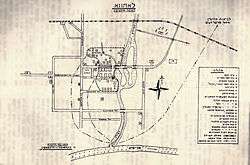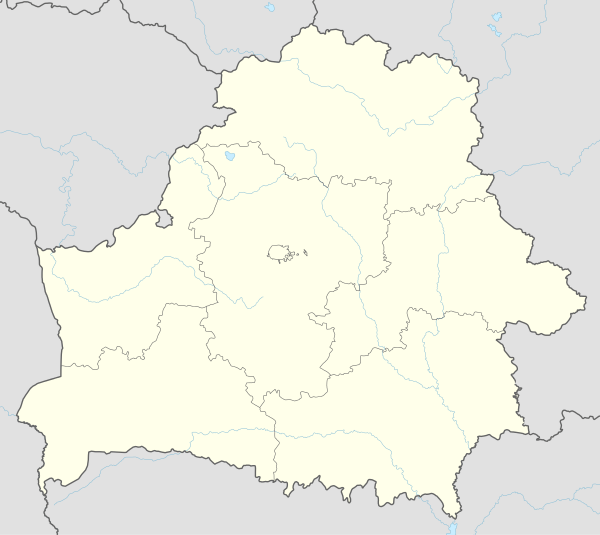Łachwa Ghetto
| Łachwa Ghetto | |
|---|---|
| Transit ghetto | |
|
Łachwa location east of Brześć Ghetto and Sobibór extermination camp during World War II
 | |
 Location in modern day Belarus | |
| Coordinates | 52°13′N 27°6′E / 52.217°N 27.100°ECoordinates: 52°13′N 27°6′E / 52.217°N 27.100°E |
| Known for | The Holocaust in Poland |
Łachwa (or Lakhva) Ghetto was a World War II ghetto created by Nazi Germany on 1 April 1942 in the town of Łachwa in occupied eastern Poland (now Lakhva, Belarus),[1] with the aim of persecution, terror and exploitation of the local Jews. The ghetto existed only until September 1942. It was the location of one of the first,[2] and possibly the first,[3][4] Jewish ghetto uprising following the Nazi–Soviet Invasion of Poland.[5]
History
The town was granted municipal charter by the Radziwiłł princes in 1608. The first Jews settled in Łachwa, Poland, after the Khmelnytsky Uprising (1648-1650). In 1795 there were 157 tax-paying Jewish citizens in Łachwa; already a majority of its inhabitants. Main sources of income were trade in agricultural products and in fishing, expanded into meat and wax production, tailoring, and transportation services. Several decades after the Partitions of Poland by Russia, Prussia and Austria, the railway line Vilna-Luninets-Rivne (Wilno-Łuniniec-Równe) extended to Lakhva, helping local economies withstand the downturn. In 1897 there were 1,057 Jews in the town.[6]
After the reconstitution of sovereign Poland in 1918, Łachwa became part of the Polesie Voivodeship in the Kresy macroregion. Jewish cultural life flourished. There was a well stocked library, political parties and zionist organizations; the Tarbut school of Hebrew learning, and the live-theater association. Łachwa population was 33 percent Jewish in 1921. Eliezer Lichtenstein was the last Rabi before the Soviet invasion of Poland in 1939.[6]
World War II ghetto and development of resistance
Two years into World War II, on 22 June 1941 the German army entered the Soviet occupation zone under the codename Operation Barbarossa, and two weeks later on 8 July 1941, overran the town of Łachwa along with the entire Polesie Voivodeship of the Polish Republic, which was incorporated into the USSR in 1939 in the atmosphere of terror.[7][8][9] During the German attack, many young Jews escaped east with the retreating Red Army.[10] A Judenrat was established by the Germans, headed by a former Zionist leader, Dov Lopatyn.[2] Rabbi Hayyim Zalman Osherowitz was arrested by the police. His release was secured later, only after the payment of a large ransom.[11]
.jpg)
On 1 April 1942, the town's Jewish residents were forcibly moved into a new ghetto consisting of two streets and 45 houses, and surrounded by a barbed wire fence.[4][8] The ghetto housed roughly 2,350 people, which amounted to approximately 1 square metre (11 sq ft) per person.[11]
The news of massacres, committed throughout the region by German Einsatzkommandos, soon spread to Łachwa. The Jewish youth organized an underground resistance under the leadership of Isaac Rochczyn (also spelled Yitzhak Rochzyn or Icchak Rokchin), the head of the local Betar group. With the assistance of Judenrat, the underground managed to stockpile axes, knives, and iron bars, although efforts to secure firearms were largely unsuccessful.[4][8][11]
By August 1942, the Jews in Łachwa knew that the nearby ghettos in Łuniniec (Luninets) and Mikaszewicze (now Mikashevichy, Belarus) had been liquidated. On 2 September 1942, the local populace were informed that some farmers, summoned by the Nazis, had been ordered to dig large pits just outside the town. Later that day, 150 German soldiers from an Einsatzgruppe killing squad with 200 local Belarusian and Ukrainian auxiliaries surrounded the ghetto. Rochczyn and the underground wanted to attack the ghetto fence at midnight to allow the population to flee, but others refused to abandon the elderly and children. Lopatyn asked that the attack be postponed until the morning.[8][11][12][13]
Uprising and massacre
On 3 September 1942, the Germans informed Dov Lopatyn that the ghetto was to be liquidated, and ordered the ghetto inhabitants to gather for "deportation". To secure the cooperation of the ghetto's leaders, the Germans promised that the members of Judenrat, the ghetto doctor and 30 labourers (whom Lopatyn could choose personally) would be spared. Lopatyn refused the offer, reportedly responding: "Either we all live, or we all die."[4][8][11]
When the Germans entered the ghetto, Lopatyn set fire to the Judenrat headquarters, which was the signal to commence the uprising.[2] Other buildings were also set on fire. Members of the Ghetto underground attacked the Germans as they entered the ghetto, using axes, sticks, molotov cocktails and their bare hands. This battle is believed to represent the first ghetto uprising of the war. Approximately 650 Jews were killed in the fighting or in the flames, with another 500 or so taken to the pits and shot. Six German soldiers and eight German and Ukrainian (or Belarusian) policemen were also killed. The ghetto fence was breached and approximately 1,000 Jews were able to escape, of whom about 600 were able to take refuge in the Prypeć (Pripet) Marshes. Rochczyn was shot and killed as he jumped into the Smierc River, after killing a German soldier with an axe to the head. Although an estimated 120 of the escapees were able to join partisan units, most of the others were eventually tracked down and killed. Approximately 90 residents of the ghetto survived the war.[4] Dov Lopatyn joined a communist partisan unit and was killed on 21 February 1944 by a landmine.
Aftermath
The Red Army reached Łachwa in mid-July 1944 during Operation Bagration.[8] After World War II ended, Poland's borders were redrawn, according to the demands made by Josef Stalin during Tehran Conference confirmed (as not negotiable) at the Yalta Conference of 1945. Lakhva (Cyrillic: Лахва) was then incorporated into the Byelorussian SSR of the Soviet Union. The Polish population was expelled and forcibly resettled within the new borders of Poland before the end of 1946. The Jewish community was never restored. Since the dissolution of the Soviet Union in 1991, Lakhva has been one of the smaller towns in the Luninets district of Brest Region in sovereign Belarus.[14][15]
References
- ↑ Paul R. Bartrop (2016). Resisting the Holocaust: Upstanders, Partisans, and Survivors. ABC-CLIO. pp. 163–165. ISBN 1610698797.
- 1 2 3 Lachva, Encyclopedia Judaica, 2nd ed., Volume 12, pp. 425–426 (Macmillan Reference USA, 2007)
- ↑ Michaeli, Lichstein, Morawczik, Sklar, eds. (1957). First Ghetto to Revolt: Lachwa. Tel Aviv: Entsyklopedyah shel Galuyot.
- 1 2 3 4 5 Suhl, Yuri (1967). They Fought Back: Story of the Jewish Resistance. New York: Paperback Library Inc. pp. 181–183. ISBN 0805235930.
- ↑ "Łachwa". Jewish community. Warsaw: Virtual Shtetl, POLIN Museum of the History of Polish Jews. 2017 – via Internet Archive.
- 1 2 "Łachwa". History of the Jewish community (in Polish). Warsaw: Virtual Shtetl, POLIN Museum of the History of Polish Jews. 2012 – via Internet Archive.
- ↑ Bernd Wegner, ed. (1997). From peace to war: Germany, Soviet Russia, and the world, 1939–1941. The period of Soviet-German partnership. Berghahn Books. pp. 74–. ISBN 1571818820.
- 1 2 3 4 5 6 Lachva, Multimedia Learning Centre: The Simon Wiesenthal Center (last accessed 30 September 2006, no archive). Timeline of the Holocaust.
- ↑ Keith Sword, ed. (1991). The Soviet Takeover of the Polish Eastern Provinces, 1939–41. The mass deportations of the Polish population to the USSR. Springer. p. 224. ISBN 1349213799.
- ↑ "Łachwa – History". Virtual Shtetl Museum of the History of Polish Jews. Retrieved 21 July 2011.
- 1 2 3 4 5 Pallavicini, Stephen and Patt, Avinoam. "Lachwa", An Encyclopedic History of Camps, Ghettos, and Other Detention Sites in Nazi Germany and Nazi-Dominated Territories, 1933–1945: United States Holocaust Memorial Museum
- ↑ This Month in Holocaust History: September 3, 1942.
- ↑ Yad Vashem, The Holocaust Martyrs' and Heroes' Remembrance Authority; accessed 27 April 2014.
- ↑ Sylwester Fertacz (2005). "Carving of the Poland's new map" [Krojenie mapy Polski: Bolesna granica]. Magazyn Społeczno-Kulturalny Śląsk. Retrieved 3 September 2017 – via the Internet Archive.
- ↑ Simon Berthon, Joanna Potts (2007). Warlords: An Extraordinary Re-Creation of World War II. Da Capo Press. p. 285. ISBN 0306816504.
External links
Pre-war Polish topographic maps showing Łachwa